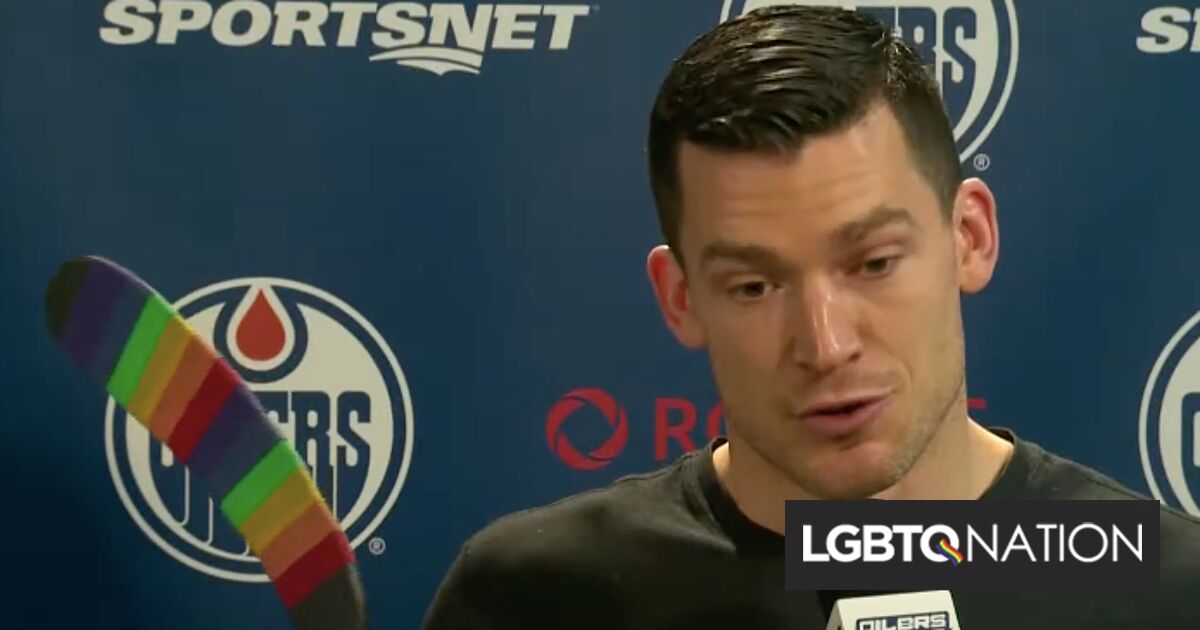The National Hockey League (NHL), the highest-level professional ice hockey league representing 32 North American teams, has banned individual players from wrapping their hockey sticks with rainbow-colored Pride Tape during warm-ups, games, and practices.
The new prohibition is just the latest development in the NHL’s rollback of its LGBTQ+ support amid a wave of anti-queer blowback to companies that support queer Pride. The prohibition flies in the face of the league’s LGBTQ±inclusive Hockey is for Everyone campaign.
Last Thursday, the NHL issued a memo to all teams with “clarification” on its June decision to ban players from wearing Pride-themed warm-up jerseys during the teams’ LGBTQ±inclusive Pride nights. The ban also prevents players from wearing jerseys commemorating military veterans, people with cancer, and others.
The new memo said, in part, “Players shall not be put in the position of having to demonstrate (or where they may be appearing to demonstrate) personal support for any Special Initiatives. A factor that may be considered in this regard includes, for example, whether a Player (or Players) is required to be in close proximity to any groups or individuals visibly or otherwise clearly associated with such Special Initiative(s).”
The broadly written “clarification” could technically mean that players could refuse to be on the ice if there is a drag queen, a gay men’s chorus singing the National Anthem, or even out gay players present, the LGBTQ+ sports website Outsports noted.
The aforementioned website also confirmed that the NHL has banned individual players from applying Pride Tape onto their hockey sticks. Proceeds from the sale of the rainbow-colored tape have gone towards LGBTQ+ youth outreach and educational initiatives, Pride Tape’s website states.
Queerty noted that the Thursday memo specified that “specialty jerseys may be sold as merchandise, they just can’t be on the ice,” meaning that “the NHL is still happy to take LGBTQ+ fans’ money. But won’t stand up for them in the face of a few homophobes.”
Last June, NHL commissioner Gary Bettman talked to Sportsnet about the rainbow-colored jerseys and how some players have refused to wear them.
“It’s become a distraction,” Bettman said. “And taking away from the fact that all of our clubs host nights in honor of various groups or causes, and we’d rather they continue to get the appropriate attention they deserve and not be a distraction.”
Bettman’s “distraction” comment may reference instances like what happened last January when Philadelphia Flyers’ player Ivan Provorov refused to take part in his team’s Pride Night warm-up session because he didn’t want to wear a rainbow-colored jersey. He said the jersey violated his Russian Orthodox Christian beliefs.
Bettman noted that NHL teams will still host Pride nights; players just won’t wear rainbow-colored jerseys during those nights. In a statement against the jersey ban, You Can Play, an organization opposing queerphobia in sports, said that they were “concerned and disappointed” by the new policy.
“Today’s decision means that the over 95% of players who chose to wear a Pride jersey to support the community will now not get an opportunity to do so. Pride nights will continue and we look forward to further enhancing the programming these opportunities bring to the mission of inclusion and belonging for the 2SLGBTQ+ community given this restriction,” the organization said.
This past Pride season, queerphobic conservative activists orchestrated boycotts of Target and Bud Light for including the LGBTQ+ community in their marketing. These activists admitted that their goal is to make Pride “toxic” to brands. If the NHL is any indication, that campaign is working.
Outsports added, ” The NHL was one of only two major pro sports leagues in North America to never change their X avatar to a rainbow during 2023’s Pride Month (the other was the NFL).”



It is in your face, especially during pride month. But that’s the point. It’s in your face so we can talk about how gay people are treated, what they’ve overcome, and show that they are being included in places they previously weren’t. You can’t do that if it’s not in your face.
So, they’ve got a point when they claim that gay symbolism is pushy. I’d ask them why they think it’s useful to be pushy.
deleted by creator